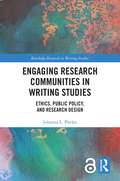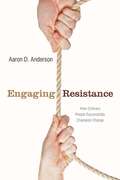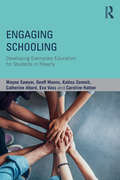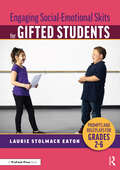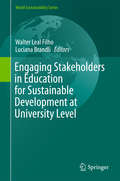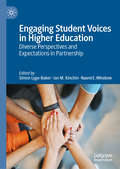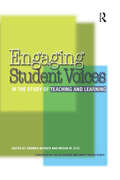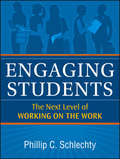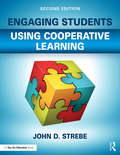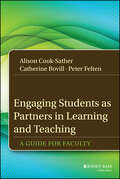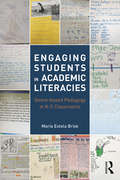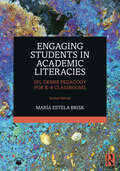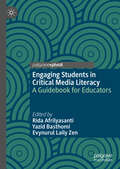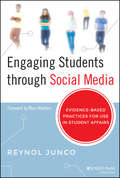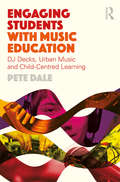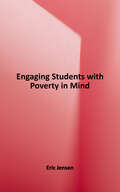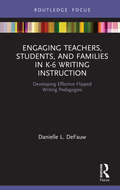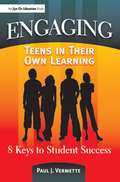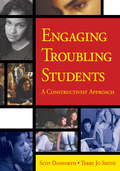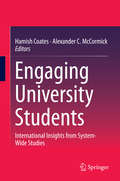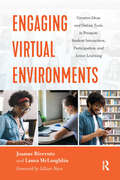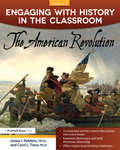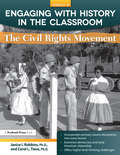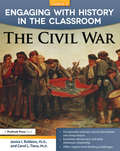- Table View
- List View
Engaging Research Communities in Writing Studies: Ethics, Public Policy, and Research Design (Routledge Research in Writing Studies)
by Johanna PhelpsThis book invites readers to reconsider how writing studies researchers work with Institutional Review Boards (IRBs) on behalf of their communities and argues that engaging with IRBs during the research design process helps practitioners conduct research more quickly and effectively. Using empirical data from both writing studies and extra-disciplinary contexts, Dr. Johanna Phelps presents findings from two discipline-wide studies, as well as metadata from two IRBs, to develop a principled engagement framework for writing studies researchers to interact with their communities. Phelps further examines the many facets of conducting research with human participants—from comprehending federal policy updates to pondering specific ethical issues to developing detailed research designs—and explores the confluence of ethics, policy, and methodology in a thoroughgoing philosophical investigation of writing studies as a public good. This engaging and timely exploration of research design will be an important resource for scholars and students of writing studies; rhetoric and composition; technical and professional communication; cultural rhetoric; literacy studies; research design; research methodologies; research ethics; IRBs; justice; and critical theory. Chapter 4 and Interchapter 4 of this book are freely available as a downloadable Open Access PDF under a Creative Commons Attribution-Non Commercial-No Derivatives 4.0 license https://www.taylorfrancis.com/books/engaging-research-communities-writing-studies-johanna-phelps/10.4324/9781003082002?context=ubx&refId=07fec855-89cc-48d3-b893-fbcd53272512. Chapter 6 and Interchapter 6 of this book are freely available as a downloadable Open Access PDF under a Creative Commons Attribution-Non Commercial-No Derivatives 4.0 license https://www.taylorfrancis.com/books/engaging-research-communities-writing-studies-johanna-phelps/10.4324/9781003082002?context=ubx&refId=07fec855-89cc-48d3-b893-fbcd53272512.
Engaging Resistance: How Ordinary People Successfully Champion Change
by Aaron D. AndersonEngaging Resistance: How Ordinary People Successfully Champion Change offers an empirically based explanation that expands our understanding about the nature of resistance to organizational change and the effects of champion behavior. The text presents a new model describing how resistance occurs over time and details what change proponents can do throughout three engagement periods to effectively work with hesitant colleagues. The book's findings are illuminated by examples of six different resistance cases, embedded in the transformation sagas of two real-world organizations. A fundamental premise of this work is that resistance should not be something to avoid or squash as people work to change their organizations. In fact, resistance can be viewed as a natural, healthy part of an organic process. When engaged properly, resisters can help to improve change efforts and strengthen an organization's overall transformation.
Engaging Schooling: Developing Exemplary Education for Students in Poverty
by Caroline Hatton Wayne Sawyer Geoff Munns Katina Zammit Catherine Attard Eva VassIn Engaging Schooling, the authors use case studies to engagingly demonstrate how schools can use pedagogical change to enable students from low SES backgrounds to benefit academically and socially from their schooling. The book, which builds on Exemplary Teachers of Students in Poverty from the same research team, deals with key issues around the reshaping of schooling and teaching, focusing on structures for mentoring and research practice among teachers. It significantly advances international literature that highlights the role of pedagogy for engagement in the educational success of students from low SES backgrounds. Moving beyond the individual classroom to focus on whole-school change, the book provides a clearer picture of processes which schools might undergo to engage students in low SES contexts, including teacher research, mentoring practices, instructional leadership and classroom discourses. The book will be of interest to all students, teachers and professional researchers in the field of teacher education.
Engaging Social-Emotional Skits for Gifted Students: Prompts and Roleplays for Grades 2-6
by Laurie Stolmack EatonEngaging Social-Emotional Skits for Gifted Students gives you all the tools you need to help gifted children expand social skills and develop a better understanding of self, peer relations, task commitment, and leadership through insightful, engaging roleplay! Presented in an easy-to-read, conversational style using real-world examples, these open-ended roleplay scenarios teach students how to recognize, monitor, and adjust their behavior. Covering topics from anxiety to patience to teasing and cooperation, each skit includes a problem that invites students to develop their own solutions and takeaways from the situation. Ideal for learners in grades 2–6, these skits allow gifted students to engage with social-emotional learning, making tackling difficult social and emotional issues nonthreatening and fun.
Engaging Stakeholders in Education for Sustainable Development at University Level
by Walter Leal Filho Luciana BrandliThis book discusses the role of ESD stakeholders at university level, involving civil society and the private sector and public sectors (including local, national and intergovernmental bodies). In particular, it describes practical experiences, partnerships, networks, and training schemes for increasing the capacity of ESD and other initiatives aimed at promoting education for sustainable development taking place at institutions of higher education. In order to meet the pressing need for publications that may promote stakeholders' involvement in ESD in higher education, the book particularly focuses on state-of-the-art approaches, methods, initiatives and projects from around the world, illustrating the contribution of different stakeholder groups to sustainable development in higher education on an international scale.
Engaging Student Voices in Higher Education: Diverse Perspectives and Expectations in Partnership
by Ian M. Kinchin Naomi E. Winstone Simon Lygo-BakerThis book examines the importance of exploring the varied and diverse perspectives of student experiences. In both academic institutions and everyday discourse, the notion of the ‘student voice’ is an ever-present reminder of the importance placed upon the student experience in Higher Education: particularly in a context where the financial burden of undertaking a university education continues to grow. The editors and contributors explore how notions of the ‘student voice’ as a single, monolithic entity may in fact obscure divergence in the experiences of students. Placing so much emphasis on the ‘student voice’ may lead educators and policy makers to miss important messages communicated – or consciously uncommunicated – through student actions. This book also explores ways of working in partnership with students to develop their own experiences. It is sure to be of interest and value to scholars of the student experience and its inherent diversity.
Engaging Student Voices in the Study of Teaching and Learning
by Carmen Werder, Megan M. Otis, Pat Hutchings, Mary Taylor HuberThis book addresses the all-important dimensions of collaboration in the study of learning raised by such questions as: Should teachers engage students directly in discussions and inquiry about learning? To what extent? What is gained by the collaboration? Does it improve learning, and what do shared responsibilities mean for classroom dynamics, and beyond?Practicing what it advocates, a faculty-student team co-edited this book, and faculty-student (or former student) teams co-authored eight of its eleven chapters. The opening section of this book explores such dimensions of student voices in the scholarship of teaching and learning (SoTL) as power and authority in the classroom, collaborative meaning-making, and the role of students as both learners and experts on their own learning. It opens up the process of knowledge-building to a wider group of participants, and expands our conception of who has expertise to contribute – for instance recognizing students’ “insider” knowledge of themselves as learners. Using various institutional models to illustrate these foundational concepts, part one provides a context for understanding the detailed examples that follow. The case studies in the second half of the volume illustrate how these concepts play out inside and outside the classroom when students shift from serving as research subjects in a SoTL study to working as independent researchers or as partners with faculty in such work as studying curricular design/redesign, readings, requirements, and assessment. This co-inquiry brings the principles and benefits of the broader undergraduate research movement to the topic of teaching and learning. It also increases student researchers’ sense of themselves as independent learners. While recognizing the impossibility of engaging every student in the scholarship of teaching and learning in every course, the editors and contributors make the case for making such opportunities available as broadly as possible because, as this volume also makes clear, this is transformational work – with the potential to produce paradigm shifts, turning points, new insights, and changes in classroom culture – for both faculty and students. The contributors demonstrate how they validated student voices in theory, method, and methodology across a wide variety of disciplines and while engaging with different pedagogies. Disciplinary examples include: anthropology, communication, chemistry, criminal science, education, English, geography, history, human services, mathematics, psychology, sociology, theater arts, philosophy, and political science.
Engaging Students
by Phillip C. SchlechtyIn Phillip Schlechty's best-selling book Working on the Work, he outlined a motivational framework for improving student performance by improving the quality of schools designed for students. Engaging Students offers a next-step resource in which Schlechty incorporates what he's learned from the field and from the hundreds of workshops he and the Schlechty Center staff have conducted since Working on the Work was first published. This innovative and practical book is focused on helping teachers become increasingly successful in designing engaging work for their students. Schlechty contends that rather than viewing schools as teaching platforms, schools must be viewed as learning platforms. Rather than seeing schools as knowledge distribution systems, schools must be seen as knowledge work systems. Rather than defining teachers as instructors, teachers must be defined as designers, leaders, and guides to instruction. Engaging Students also includes useful questionnaires that will facilitate discussion, analysis, and action planning at both school and classroom levels. Praise for Engaging Students "In Engaging Students, Schlechty boldly delineates why the focus on engaging students overrides the focus on test scores. Every teacher and administrator in my district will use this guide to transform our entire organization into one that is truly focused on student engagement. "-Kim Redmond, superintendent, Canton Local Schools, Canton, Ohio "This insightful book reminds us that every decision made in schools should ultimately benefit students. You will find yourself referring to this book again and again as a guide to support you in your role as an educator. "-Allene Magill, executive director, Professional Association of Georgia Educators, Atlanta, Georgia "Here is a much-enriched framework for everything Dr. Schlechty advocates: well articulated curriculum standards, schools as a platform for learning, teachers as leaders and designers of engaging and meaningful work, and students becoming responsible for their learning. "-Nyana Sims, K-12 literacy and induction facilitator, Goshen School District, Torrington, Wyoming "By understanding and implementing the principles so thoughtfully articulated in this book, schools can become centers of highly engaged learners-and in that endeavor find again the joy of teaching and learning. "-Johnny Veselka, executive director, Texas Association of School Administrators, Austin, Texas
Engaging Students Using Cooperative Learning
by John D. StrebeMotivate your students and create an engaging classroom environment with the time-tested strategies in this book. Drawing on over 35 years of experience, author and consultant John D. Strebe offers a wealth of advice for teachers who want to encourage collaboration and team learning among students of all grade levels. This expanded second edition includes activities and examples across the subject areas, as well as new reproducible tools for classroom use. Topics include… Building enthusiasm and increasing student development with games, mini competitions, and team projects. Implementing new seating arrangements that promote discussion and participation. Keeping students engaged during lectures and presentations. Facilitating group work by organizing students into teams based on academic skills and personal traits. And more! John D. Strebe taught secondary mathematics for 38 years in the Maryland public schools. He conducts workshops for teachers across the country, providing instruction on setting up a cooperative and engaging classroom.
Engaging Students as Partners in Learning and Teaching: A Guide for Faculty
by Peter Felten Alison Cook-Sather Catherine BovillA guide to developing productive student-faculty partnerships in higher education Student-faculty partnerships is an innovation that is gaining traction on campuses across the country. There are few established models in this new endeavor, however. Engaging Students as Partners in Learning and Teaching: A Guide for Faculty offers administrators, faculty, and students both the theoretical grounding and practical guidelines needed to develop student-faculty partnerships that affirm and improve teaching and learning in higher education. Provides theory and evidence to support new efforts in student-faculty partnerships Describes various models for creating and supporting such partnerships Helps faculty overcome some of the perceived barriers to student-faculty partnerships Suggests a range of possible levels of partnership that might be appropriate in different circumstances Includes helpful responses to a range of questions as well as advice from faculty, students, and administrators who have hands-on experience with partnership programs Balancing theory, step-by-step guidelines, expert advice, and practitioner experience, this book is a comprehensive why- and how-to handbook for developing a successful student-faculty partnership program.
Engaging Students in Academic Literacies: Genre-Based Pedagogy for K-5 Classrooms
by María Estela BriskThe Common Core State Standards require schools to include writing in a variety of genres across the disciplines. Engaging Students in Academic Literacies provides specific information to plan and carry out genre-based writing instruction in English for K-5 students within various content areas. Informed by systemic functional linguistics—a theory of language IN USE in particular ways for particular audiences and social purposes—it guides teachers in developing students’ ability to construct texts using structural and linguistic features of the written language. This approach to teaching writing and academic language is effective in addressing the persistent achievement gap between ELLs and "mainstream" students, especially in the context of current reforms in the U.S. Transforming systemic functional linguistics and genre theory into concrete classroom tools for designing, implementing, and reflecting on instruction and providing essential scaffolding for teachers to build their own knowledge of its essential elements applied to teaching, the text includes strategies for apprenticing students to writing in all genres, features of elementary students’ writing, and examples of practice.
Engaging Students in Academic Literacies: SFL Genre Pedagogy for K-8 Classrooms
by María Estela BriskThe second edition of this important and practical text provides specific information to guide teachers in planning and carrying out genre writing instruction in English for K–8 students within the content areas. Informed by systemic functional linguistics (SFL)—a framework conducive to instruction that views language as a meaning-making resource—this book guides teachers by presenting concrete ways to teach writing in the language arts, science, and social science curricula. Introducing theory of language that is effective in addressing the writing development of all students, especially multilingual/multicultural groups, the book provides essential scaffolding for teachers to design and implement effective, inclusive curricula while building their own knowledge. Fully up to date, the second edition features new genres appropriate for middle school, examples of student writing, an expanded focus on genre pedagogy, a new chapter on bilingual learners, guidance for teaching in the middle grades, as well as clear steps to prepare genre units based two decades of experience working with whole schools. The chapter units cover distinct genres, including memoirs, historical, genres, fictional narratives, arguments, and more. With ready-to-use tools, the new edition prepares elementary and middle school teachers to meet and adapt to the variable demands of their own educational contexts. Easy to navigate, this teacher-friendly text is an essential resource for courses in academic writing, English education, and multilingual education, and for pre-service and practicing English Language Arts (ELA) teachers who want to expand their teaching abilities and knowledge bases.
Engaging Students in Critical Media Literacy: A Guidebook for Educators
by Yazid Basthomi Evynurul Laily Zen Rida AfrilyasantiThis edited book presents the integration of Critical Media Literacy (CML) principles into teaching English as a Foreign Language (EFL). This approach has its roots in content-based language learning, which aims to promote effective communication as the ultimate goal of language acquisition. This book highlights the profound influence of CML on educational methods, exploring the evolving concepts that support its integration and providing both theoretical perspectives and practical examples to illustrate its implementation. The book delineates methodologies for constructing and executing a CML integration framework in EFL lessons, offering various instructional strategies and reflective analyses and integrating the viewpoints of professionals, educators, and researchers. The book explores the complexities of CML, discussing the changing nature of language instruction in a world heavily influenced by media, and explores issues such as professional growth during educational restructuring, highlighting the significance of personal metamorphosis in attaining social equity. This book offers a concise yet thorough examination of CML integration in EFL settings, and it will be of interest to scholars specializing in education, media studies, and language instruction, as well as educators actively engaged in teaching, such as EFL teachers, curriculum developers, and educational policymakers.
Engaging Students through Social Media
by Reynol JuncoUsing social media to enhance learning outcomes, engagement, and retention Although research shows that most of today's college students adopt and use social media at high rates, many higher education professionals are unaware of how these technologies can be used for academic benefit. Author Reynol Junco, associate professor at Purdue University and fellow at the Harvard Berkman Center for Internet & Society, has been widely cited for his research on the impact of social technology on students. In Engaging Students through Social Media: Evidence-Based Practice for Use in Student Affairs, he offers a practical plan for implementing effective social media strategies within higher education settings. The book bridges the gap between a desire to use social media and the process knowledge needed to actually implement and assess effective social media interventions, providing a research-based understanding of how students use social media and the ways it can be used to enhance student learning. Discover how social media can be used to enhance student development and improves academic outcomes Learn appropriate strategies for social media use and how they contribute to student success in both formal and informal learning settings Dispel popular myths about how social media use affects students Learn to use social media as a way to engage students, teach online civil discourse, and support student development The benefits of social media engagement include improvements in critical thinking skills, content knowledge, diversity appreciation, interpersonal skills, leadership skills, community engagement, and student persistence. This resource helps higher education professionals understand the value of using social media, and offers research-based strategies for implementing it effectively.
Engaging Students with Music Education: DJ decks, urban music and child-centred learning
by Pete DaleEngaging Students with Music Education is a groundbreaking book about using DJ decks and urban music in mainstream schools to re-engage disaffected learners and develop a curriculum which better reflects overall contemporary tastes. Many young learners are ‘at risk’ of exclusion; this book argues that for such individuals, the implications of such a shift in the music curriculum could be especially positive. Drawing extensively on the author’s own wealth of teaching experience, and bridging the gap between practice and theory, this book demonstrates through case studies that DJ decks can prove extremely valuable in mainstream classroom situations across the secondary school age ranges. Addressing challenging and crucial topics, combining rigorous theoretical analysis with practical suggestions, the book addresses questions such as: Are DJ decks actually a musical instrument, and are they suitable for classroom teaching? Will Ofsted's school inspectors approve of music teaching involving DJ decks and urban music? If we bring urban music into the classroom, will this further marginalise classical music? Are DJing and MCing skills recognised within examination specifications, at least in the UK? Current teachers will find the practical advice on how to incorporate DJ decks and urban music into their classroom especially helpful, whilst educational researchers will be captivated by the critical discussion of the child-centred tradition and a theoretical approach which stretches from ‘continental’ philosophy to practice-based reflection. With an insistence that the starting point for music education should always be the interests and experiences of the learners, this book is essential reading for those music teachers and researchers interested in the benefits of non-standard music-making in the classroom.
Engaging Students with Poverty in Mind: Practical Strategies for Raising Achievement
by Eric JensenIn this galvanizing follow-up to the best-selling Teaching with Poverty in Mind, renowned educator and learning expert Eric Jensen digs deeper into engagement as the key factor in the academic success of economically disadvantaged students. Drawing from research, experience, and real school success stories, Engaging Students with Poverty in Mind reveals: - Smart, purposeful engagement strategies that all teachers can use to expand students' cognitive capacity, increase motivation and effort, and build a deep, enduring understanding of content. - The (until now) unwritten rules for engagement that are essential for increasing student achievement. - How automating engagement in the classroom can help teachers use instructional time more effectively and empower students to take ownership of their learning. - Steps you can take to create an exciting yet realistic implementation plan. Too many of our most vulnerable students are tuning out and dropping out because of our failure to engage them. It's time to set the bar higher. Until we make school the best part of every student's day, we will struggle with attendance, achievement, and graduation rates. This timely resource will help you take immediate action to revitalize and enrich your practice so that all your students may thrive in school and beyond.
Engaging Teachers, Students, and Families in K-6 Writing Instruction: Developing Effective Flipped Writing Pedagogies (Routledge Research in Literacy Education)
by Danielle L. DeFauwThis text draws on interviews, assignments, field notes, and observations from a flipped writing methodology course conducted with preservice elementary teachers in the US. In doing so, the text powerfully illustrates the benefits of using flipped methodologies in K-6 instruction to engage students, teachers, and families in authentic writing practices. Engaging Teachers, Students, and Families in K-6 Writing Instruction demonstrates the use of flipped writing methodologies to engage preservice teachers in literacy instruction, increase their confidence as writers, and bolster their understanding and application of pedagogical content knowledge. In turn, this underpins teachers’ ability to teach writing as an authentic, purpose-driven, audience-focused process. In particular, chapters explore effective teaching strategies including writing clinics, writing contests, and family literacy sessions which encourage writing development within a community of students, teachers, families, and authors. This text will be an engaging and informative guide for educational researchers, teacher educators, and preservice and inservice teachers looking to develop effective flipped writing pedagogies to support educators, students, and families.
Engaging Teaching Tools: Measuring and Improving Student Engagement
by David U. SladkeyEnergize your students through active learning! Engagement is critical to positive classroom climate and individual student achievement. Yet it can be elusive. This teacher-friendly flip book provides strategies to maximize student involvement and confidence in the learning process. In this easy-to-use companion to Energizing Brain Breaks, you’ll find: More than sixty practical, easy-to-implement, teaching ideas. Strategies improve questioning techniques, adjust attitudes, and involve parents. The Engagement Wheel, a downloadable self-evaluation tool to measure student participation and guide lesson planning. Access to a free PowerPoint or SmartBoard version.
Engaging Teens in Their Own Learning: 8 Keys to Student Success
by Paul VermetteThis book offers valuable teaching strategies to engage a diverse group of teens in thinking, understanding, and learning activities.
Engaging Troubling Students: A Constructivist Approach
by Scot Danforth Terry Jo SmithFilled with rich narrative and designed for educators working with troubling students each day, this insightful, practical guide leads you in developing helpful, trusting student-teacher relationships.
Engaging University Students
by Hamish Coates Alexander C. MccormickThis book provides university teachers, leaders and policymakers with evidence on how researchers in several countries are monitoring and improving student engagement--the extent to which students are exposed to and participate in effective educational practices. It captures insights from international implementations of the National Survey of Student Engagement (NSSE), developed in the United States. In the last half decade NSSE has been adapted and used in several other countries, producing the largest international collaboration yet involving educationally relevant data on students' engagement in higher education. Leaders of established national collaborations draw on their experiences with hundreds of institutions to contribute their insights. Framed by their cultural and educational contexts, they discuss issues concerning first-year learners, international students, part-time and distance learners, as well as teaching and leadership in support of student learning. Each chapter outlines strategies based on national case studies and presents perspectives supported by concrete examples of how these have played out in diverse settings. The book suggests mechanisms that can be used by institutions, ministries and quality agencies around the world.
Engaging Virtual Environments: Creative Ideas and Online Tools to Promote Student Interaction, Participation, and Active Learning
by Joanne Ricevuto Laura McLaughlinIn a classroom setting interaction among students is the norm. How do you replicate that informality, spontaneity, and focus online? This book provides you with a framework to think about the different kinds of engagement you want to foster -- whether participation, collaboration, or quick feedback -- and then introduces you to available online tools, some of which may be in your LMS, offers practical tips, and guides you to how make the most of commonly available technologies to achieve your goals.Within the context and progression of a course -- from developing a welcome page, presenting yourself and the purpose of your course, to icebreakers, assignments, and alternative forms of assessment -- the authors introduce you to a range of easy-to-use online tools that they have introduced to the faculty and teachers in their classes, and that foster active learning and student engagement. In doing so they provide a checklist that you can also access and print from the Web, to help you review additional tools from the wide and ever-growing range of tools that are available online and determine whether they are appropriate for what you want to accomplish.This book will help you connect with students, whether you’re teaching synchronously or asynchronously, regardless of the devices students may be using; develop community; and introduce you to gamification to add enjoyment and variety to your students’ experience of your class.Recognizing that using new tools with confidence requires practice, the authors offer ideas for implementing them in private online spaces. Each chapter concludes with reflection questions that can be addressed individually by the reader or within a learning community to encourage faculty to work together and support each other in virtual teaching and learning. This book addresses the challenge of embracing new models of course offerings to students in the evolving landscape of virtual learning.
Engaging With History in the Classroom: The American Revolution (Grades 6-8)
by Janice I. Robbins Carol L. TiesoEngaging With History in the Classroom: The American Revolution is the first in a series of middle-grade U.S. history units that focus on what it means to be an American citizen, living in a democracy that expects as much from its citizens as it provides to them. In every lesson, students are asked to step into the world of the 18th-century American colonies, to hear about and to see what was happening, to read the words of real people and to imagine their hopes, dreams, and feelings. Students also learn to question the accounts left behind and to recognize different perspectives on events that marked the beginnings of our country as an independent nation. Resources for teachers include a running script useful as a model for guiding conceptualization as well as extensive teacher notes with practical suggestions for personalizing activities. Grades 6-8
Engaging With History in the Classroom: The Civil Rights Movement (Grades 6-8)
by Janice I. Robbins Carol L. TiesoEngaging With History in the Classroom: The Civil Rights Movement is the fourth in a series of middle-grade U.S. history units that focus on what it means to be an American citizen, living in a democracy that expects as much from its citizens as it provides to them. In every lesson, students are asked to step into the world of the Civil Rights movement, to hear about and to see what was happening, to read the words of real people, and to imagine their hopes, dreams, and feelings. Students also learn to question the accounts left behind and to recognize different perspectives on events that marked significant changes in the legal definitions of civil rights. Resources for teachers include a running script that's useful as a model for guiding conceptualization as well as extensive teacher notes with practical suggestions for personalizing activities.Grades 6-8
Engaging With History in the Classroom: The Civil War (Grades 6-8)
by Janice I. Robbins Carol L. TiesoEngaging With History in the Classroom: The Civil War is the second in a series of middle-grade U.S. history units that focus on what it means to be an American citizen, living in a democracy that expects as much from its citizens as it provides to them. In every lesson, students are asked to step into the world of 19th-century America, to hear about and to see what was happening, to read the words of real people and to imagine their hopes, dreams, and feelings. Students also learn to question the accounts left behind and to recognize different perspectives on events that divided the nation but resulted in progress in the path to liberty for all. Resources for teachers include a running script useful as a model for guiding conceptualization as well as extensive teacher notes with practical suggestion for personalizing activities.Grades 6-8
